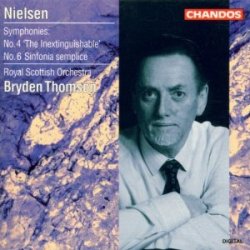Carl Nielsen – Symphony No.4 & Symphony No.6 (1993)
Carl Nielsen – Symphony No.4 & Symphony No.6 (1993)

Symphony No. 4, ‘Det Uundslukkelige’, ‘The inextinguishable’, Op. 29 (FS 76) 1. I Allegro 2. II Poco allegretto play 3. III Poco adagio quasi andante 4. IV Allegro - glorioso - Tempo giusto Symphony No. 6, ‘Sinfonia semplice’ Op. 116 (FS 116) 5. I Tempo giusto - Allegro passionato - Lento, ma non troppo - Tempo 1 (giusto) 6. II Humoreske. Allegretto 7. III Proposta Seria. Adagio play 8. IV Thema med Variationer. Allegro - Tema: Allegretto un poco - Variations I-IX - Fanfare Royal Scottish National Orchestra Bryden Thomson – conductor
Symphony No. 4 "The Inextinguishable", Op. 29, FS 76, by Danish composer Carl Nielsen, was completed in 1916. Composed against the backdrop of the First World War, this symphony is among the most dramatic that Nielsen wrote, featuring a "battle" between two sets of timpani. Danish Composer Carl Nielsen was thinking about a new symphony in 1914, and in May he wrote to his wife (who was in Celle): I have an idea for a new composition, which has no programme but will express what we understand by the spirit of life or manifestations of life, that is: everything that moves, that wants to live ... just life and motion, though varied—very varied—yet connected, and as if constantly on the move, in one big movement or stream. I must have a word or a short title to express this; that will be enough. I cannot quite explain what I want, but what I want is good.
The symphony is scored for 3 flutes (one doubling piccolo), 3 oboes, 3 clarinets, 3 bassoons (one doubling contrabassoon), 4 horns in F, 3 trumpets in C, 3 trombones, tuba, 2 sets of timpani, and strings.
The Symphony's four movements are played without breaks, this is called attacca subito. The first movement begins with a fierce tutti pitting D minor against its flat seventh, C, in an almost antiphonal manner. After the tutti, the clarinets introduce in A major the lyrical theme that will culminate the work. The second movement, for woodwind in G major, is more an intermezzo than the expected adagio. This function is fulfilled by the third movement, which opens with a cantilena from unison violins, then builds to a climax before concluding with a single oboe playing over trills in the upper strings. The clashes of the first movement reappear in the final movement, in which two sets of timpani duel from either side of the orchestra. This passage unusually calls on the two timpanists to change the pitch of the timpani while playing. At the very end E major emerges as the key to conclude the work.
The most recorded of Nielsen's symphonies, No. 4 presents some unique problems to the interpreter. In the revised version of his analysis, Robert Simpson devotes nearly a page to "features that can lead the exhibitionist conductor astray", mostly relating to matters of tempo.
Symphony No. 6 "Sinfonia semplice", (no opus number), FS 116. In August 1924 Danish composer Carl Nielsen began working on a Sixth Symphony, which turned out to be his last. By the end of October he wrote to Carl Johan Michaelsen: As far as I can see, it will on the whole be different from my other symphonies: more amiable and smooth, or how shall I put it, but it is impossible to tell as I do not know at all what currents I may run into during the voyage.
The first movement was finished at the end of November while he was in Copenhagen, and the second movement was composed during Christmas. At the end of January 1925 he traveled to the French Riviera with his wife.
While he had been in Copenhagen, Nielsen had composed the third movement, but he now had to put the symphony aside to work on a commission for incidental music to Ebbe Skammelsen, which was to be performed at the Open Air Theatre in the deer park. He completed the score immediately before his sixtieth birthday on June 9. When going to Damgaard in the middle of July, Nielsen was able to continue work on his symphony. The last movement was finally completed on December 5, 1925. The first performance was given by the Chapel Royal Orchestra on December 11. The Copenhagen reviewers were confused by the style of the new Symphony. Nielsen had called it Sinfonia semplice (Simple Symphony). Being hard to grasp, it has remained the least performed of all six symphonies.
According to Robert W. Simpson, from the second edition of his book on Nielsen, this work may be partially autobiographical; the composer had just experienced a tremendous success with his Fifth symphony, but had also suffered a series of heart attacks. He was to write several more works, but in the remaining six years of his life, the atmosphere of his works began to change.
download: uploaded yandex 4shared mediafire solidfiles mega filecloudio nornar ziddu
Last Updated (Sunday, 02 March 2014 18:23)








